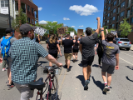Standing in unity and action: Black Lives Matter
by Samina Raja and Robert Shibley
Published June 5, 2020 This content is archived.
Architecture, urban planning, and design disciplines purport to create spaces and places where people can lead full and healthy lives. We know, however, that our professions have a long way to go before we can claim these ideals.
Along with our faculty, students, staff, and alumni, we are enraged by and grieve the recent killing of Mr. George Floyd at the hands of a police officer. The killing of a Black person is neither an isolated phenomenon nor a new one. Mr. Ahmaud Arbery was running in a neighborhood when he was killed by white strangers. Ms. Breonna Taylor, who should be celebrating her birthday today, was shot dead by the police within her own home. According to a database maintained by The Washington Post 1,276 Black people have been killed by police since 2015, at a rate twice that of white individuals.
Injustices experienced by Black people unfold on sidewalks, neighborhoods, parks, and, yes, in their own homes, as they go about their daily lives. These injustices are very much place-based. Sobering scholarship by Dr. Daniel Cooper and Dr. Ryan Lugalia-Hollon for the Chicago-Million-Dollar-Block Project illustrated that sentences and commensurate public spending for incarceration is concentrated in particular neighborhoods, especially those home to Black people. In Chicago, there are 121 city blocks where $1 million of public spending, between 2005-2009, was allocated to incarceration for non-violent drug offenses. Yet, until recently planning practice and scholarship has remained largely silent on issues of incarceration (Simpson, Steil, and Mehta 2020). Closer to home, in our own Erie County, predominantly Black neighborhoods have significantly lower access to healthful and affordable foods compared to white neighborhoods, even after you control for wealth (Raja et al. 2008). These contemporary racial food inequities in Erie County, and nationally, must be understood in the context of a food system built on the uncompensated labor of enslaved Black Americans (White 2019). Historic and place-based food inequities leave the Black community vulnerable to chronic disease, resulting in cumulative health inequities as clearly illustrated during the recent COVID 19 crisis.
Our professional training and practice - across architecture, planning, real estate and related disciplines - must be prepared to ‘see’ and eliminate the place-based injustices experienced by Black communities. We must question the historical whiteness that permeates our building disciplines, as documented by architectural historian Charles Davis II (Davis 2019). The history of urban planning in our own beloved Buffalo is no less complicated. Dr. Henry Taylor’s historic studies of Buffalo remind us how the Federal Home Owners Loan Corporation (HOLC), which made affordable mortgages possible in the US, exacerbated racial discrimination in Buffalo (Taylor 2011). HOLC fieldworkers in the early 1900s defined neighborhoods’ lack of desirability, in part, by the rate at which Blacks (or, foreign whites) might in-migrate into a neighborhood. As many locals know, the eastern part of Buffalo, where Blacks (and other ethnic groups) lived, were deemed less desirable and redlined by fieldworkers. Today, Black neighborhoods in Buffalo continue to reel under the negative impact of that structural discrimination.
Racial injustices are not new. We must redouble our efforts to address these injustices. We acknowledge, celebrate, and support our faculty, students, staff, and alumni who have been in lockstep with the broader community in Buffalo and beyond to put an end to racial injustice through their professional and personal actions. Some of our SAP community members are writing, some are engaged in delivering programming to support Black residents and neighborhoods, some are protesting, and some are making plans for how they will engage differently as architects and planners to explicitly address racial injustices. Importantly, in the last few days, many of our faculty, students, community partners, and alums have reached out to us with recommendations for clear and actionable steps that will help our school create a more just and equitable future for Black communities. We are deeply grateful for these expressions of leadership, courage, and support that hold us accountable, and we fully welcome them.
Building on the School’s collective commitment to equity, inclusion, and diversity, we will execute an explicitly anti-racist approach across all our operations and will report on our progress within the month.
Black Lives Matter.


About the authors: Samina Raja (left) is professor of urban planning, associate dean for research and inclusive excellence and director of the Food Lab at the School of Architecture and Planning. Robert Shibley (right) is dean and professor of the School of Architecture and Planning


.jpg.thumb.100.140.jpg)
